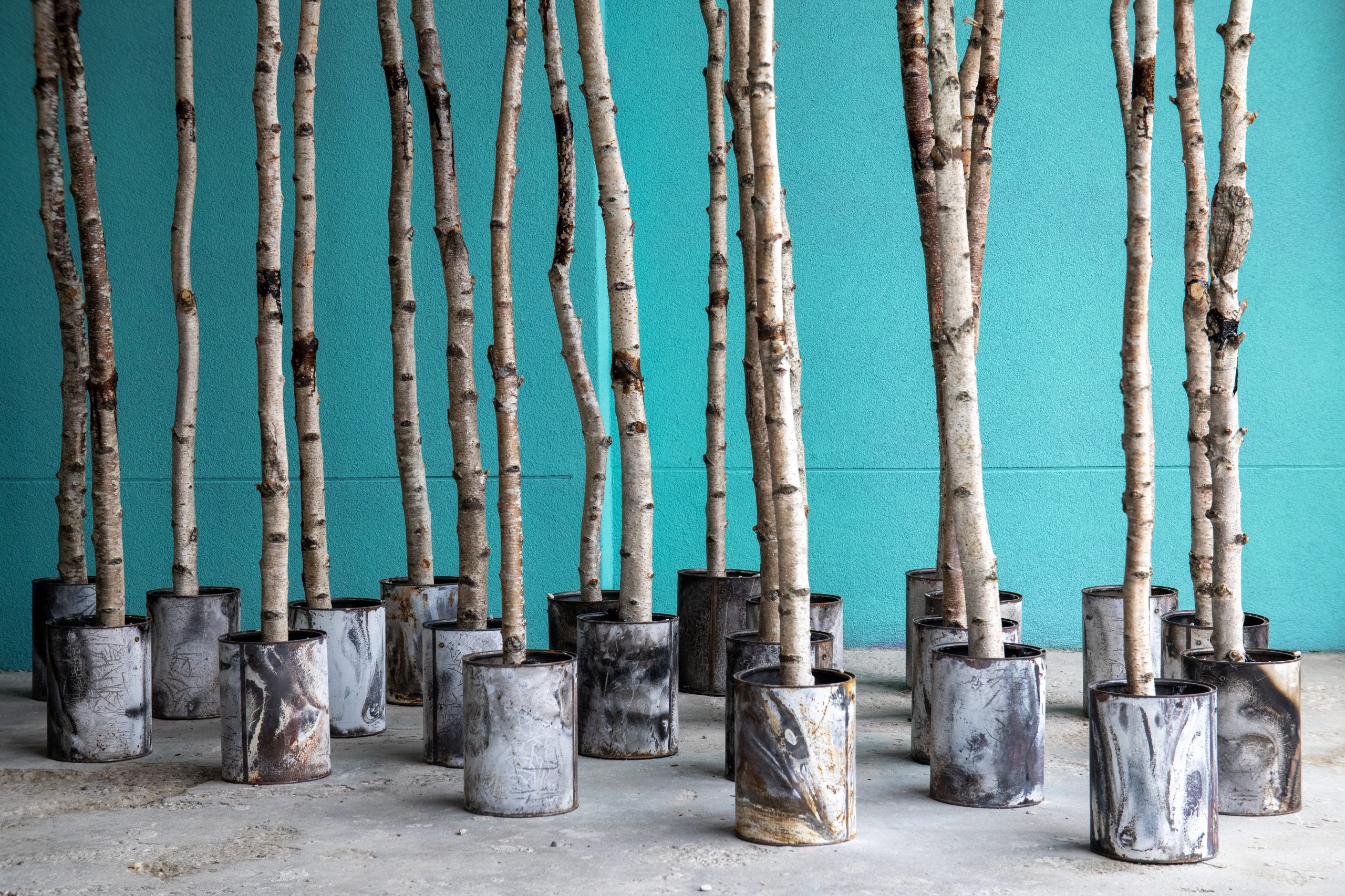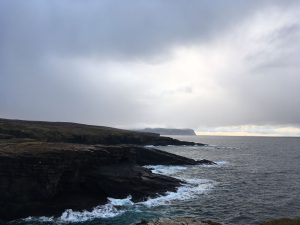

After an Open Call asking artists and writers for a creative promotional response to the themes of A Fragile Correspondence, Harvey Dimond was commissioned to write the below creative response. This three-part text considers how colonialism has shaped the natural ecologies of Scotland, South Africa and Barbados, and considers their historic and contemporary resonances from a diasporic perspective.
I
Coastal road, Loch Sween:
an evening that teeters precariously between summer and autumn.
The bracken is maroon and dying; deciduous leaves starting to yellow. The Atlantic is stern and grey. Tiny islands emerge from it like the backs of breaching whales.
The Paps of Jura, a regal presence, refract a hesitant sunset.
There is something final terminal climatic
about this place – like it has seen many departures;
A landscape that could tell you how to disappear.
On the Treshnish peninsula on the Isle of Mull, there is a cluster of ruined houses where once stood a community called Crackaig. The inhabitants were likely cleared from this land at some point in the 18th or 19th century; perhaps because of disease, perhaps because of the clearances that were plaguing these islands during this time. On one house in the ruined settlement is a small, intricate carving of a ship. Marked by a fleeing citizen, the carving suggests the inhabitants of this settlement were destined for the ocean; for the ship; an unknown and unimaginable destination.
“I have seen the townships swept, and the big holding being made of them, the people being driven out of the countryside
to the streets of Glasgow and to the wilds of Canada –
such as them that did not die of hunger and plague and smallpox while going across the ocean. I have seen the women putting the children in the carts which were being sent from Benbecuala and the Lochdar to Lochboisdale, while their husbands lay bound in the pen and were weeping beside them, without power to give them a helping hand, though the women themselves were crying aloud and their little children wailing like to break their hearts. I have seen the big strong men, the champions of the countryside, the stalwarts of the world, being bound on Lochboisdale quay and cast into the ships as would be done to a batch of horses or cattle in the boat.”
— Account of clearances on one of the islands of the Outer Hebrides (emphasis mine)
Initially, when Highlanders were cleared from their land, they were moved to the coast to work in the fishing and kelping industries – but soon the coasts would instead become points of departure for ships heading to America, New Zealand, Australia, South Africa. In discussions of the Highland Clearances and the widespread emigration from both Scotland and Ireland in the 19th and 20th centuries, it is the land that is personified as the failure – it was no longer support the people; it had let its inhabitants down. What had been their livelihoods for centuries had become their downfall. This discourse, however, diverts attention away from the fact that it was the desire to exploit and extract from this land that resulted in these mass clearances.
In turn, the land that Highlanders were cleared from was purchased by aristocratic families with money created by the slave trade. At least half of the West Highlands and Islands (around 10% of Scotland’s land area) was sold to beneficiaries of slavery during the Clearances during this time – including those who had received money from the British state to ‘compensate’ slaveowners for their “loss of property” after the abolition of slavery in 1833. In this way, we can see how the clearances were deeply entangled with the transatlantic slave trade – and how slavery was in turn funded by this new, rapid extractivism of Scottish landscapes.
II
Saint John, Barbados:
hurricane season; a series of near misses.
Getting dark now – another sleepless night lurks.
The sun sinks beneath the western fringes of the island. Here in the east, the ocean is tempestuous; rolling waves; the sound of the surf disguises the clatter of bones. The relentless Atlantic deposits its cargo on the shore – whipped by winds that sent souls as seeds to sow a colony.
The wind whispers to me; are you trying to find your way home?
Four centuries of colonialism fundamentally altered the ecologies of the islands that form the Caribbean archipelago. On ships departing from Liverpool, Calabar, Glasgow, Elmina, London, came colonisers, enslaved people, seeds, animals, diseases, faiths. These ships became floating vestibules of cross-pollination; a space where (ecological, linguistic, sexual) maritime contracts were forged – the slave ship forming its own ecology. Recordings of these transatlantic voyages – thousands of them, plying the triangular trade – hide in archives in Europe – hastily shipped back across the Atlantic to be conveniently hidden. I can imagine the feel of those documents in my hands; fragile, crisp with the salt, the sand, the sediment, the scent of the Atlantic – an oceanic palimpsest. Many Irish and Scottish people were taken to Barbados aboard these ships as criminals, political dissidents, farmers dispossessed of their land, and sold into temporary servitude (from which they were later released, and given a plot of land on the island for them to live on). This practice at the time became known as being Barbadozz’d, or Barbadosed.
(washed away / cast adrift / drop anchor / come ashore / rolled in / sea moss / ghost ships spent on the shore)
Barbados was heavily forested before the arrival of British colonisers. They cleared the trees
(usually by setting fire to them) to make way for sugar cane plantations and to feed the horses and cattle who drove the machinery for sugar production. Crops were imported largely from South America (particularly Guyana) and from England. This mass deforestation happened in only a couple of decades after the British arrived: in 1652, a prisoner of war sent to Barbados commented that “although this island lies in a pleasant location, one hears no birds.” Any forested areas that remained often became hideouts for enslaved people who had escaped from the plantations, where they formed communities of ‘maroons’. In this way, the Caribbean’s natural ecologies can be understood as a powerful conduit of resistance. Indigenous Caribbean people were also moved to Barbados from other islands to work on European plantations; their understanding of the Caribbean’s ecologies and the islands’ food sources would be crucial for the survival of all peoples that arrived on the island in the years to come.
European colonisers had deeply hostile but curious relationships with the natural environments in the tropics, an attitude that also extended to its people as a means of justifying enslavement and genocide. Karen Ordahl Kupperman writes that ‘admiration was always mixed with uneasiness in early accounts of the West Indian environment. In some ways nature seemed out of control, not moderate and tempered as in England. Trees did not bear fruit in an orderly, disciplined way as in Europe with its well-defined seasons; they had leaves, blossoms, and fruit all at once. This fecundity was pleasing to English planters, but also somewhat frightening, especially when combined with the suspicion that nature might deceive. All that beauty and lavishness sometimes seemed to hide a hollow reality… Thomas Gage argued that the attractive tropical food carried “inward and hidden deceit” and had “little substance and virtue”, which Gage attributed to its too-rapid growth. An “English Kentish Pippin” apple was far preferable. All nature deceived in the tropics.’

Orkney Coast. Photo by Amy McEwan.
III
the mountain
up
halfway
to climb
Victoria Road, Cape Town, a furious ocean threatens
Facing the Atlantic, it has never felt vaster; it seems to be at the zenith of its ferocity. These mountains, scaled by alien pine trees, are still watching – still a witness, still greeting ships as the swell propels them from the Atlantic to the Indian Ocean.
I think of being submerged deep in that water – I shiver. The ocean is the final lament. It makes all of us fragile.
I’m daydreaming about being on top of the mountain – standing high above the city which sprawls at its base. Up here, you can see the city pulsing in the heat (pre-occupied only with itself), the frenetic criss-cross of cars, trains and people. But the gentle wind, the rustling of fynbos is all that occupies my thoughts.
I’m thinking about the ways we speak – how the breath, the intonations, travel across this landscape, or across that wide sparkling ocean.
Is that an echo travelling across a wild glen, its skyscrapers of emerald eagerly absorbing the sound? What does a whistle sound like in a winter storm? On an island beach? In the post-industrial hum of the port city?
Our natural environments have always been integral to how, and why, we speak. The phenomenon of non-verbal languages is one way of understanding how the landscape has carved out our voices. ‘Whistled’ languages are a global phenomenon which have a developed in response to the specific ecologies and environments found across our planet. These languages often exist in places with ‘difficult’ terrain – in response to isolation, distance, elevation, darkness. Examples include kuş dili from the village of Kuşköy in Turkey and a dialect of the Hmong language spoken in south-west China – both of which are mountainous, isolated environments.
Perhaps the most famous whistled language is Silbo Gomero from La Gomera, in the Canary Islands archipelago. This language was used by the indigenous Gaunche people to communicate across the island’s epic terrain. When the Spanish violently colonised the island, this dialect was adapted from Gaunche languages to a Spanish phonology. The language is used for a plethora of gestures, including the announcement of weddings, funerals and warnings of inclement weather. This subtropical landscape – with its curious network of dense forests, deep ravines and cavernous valleys, seems to have carved out a language in the mouths of its inhabitants. The tone, pitch, intonation, length, frequency responds directly to the specific geography of the island – perhaps dependent on the depth of a ravine; the distance from one side of a valley to another; the density of a forest.
Languages such as Silbo Gomero, which respond to their immediate natural environment, can help us understand how to mend our broken relationship with the land; to build a relationship of reciprocity; to heal the scars of exploitation and extraction.

